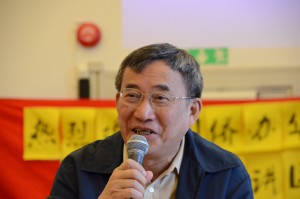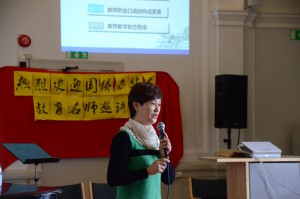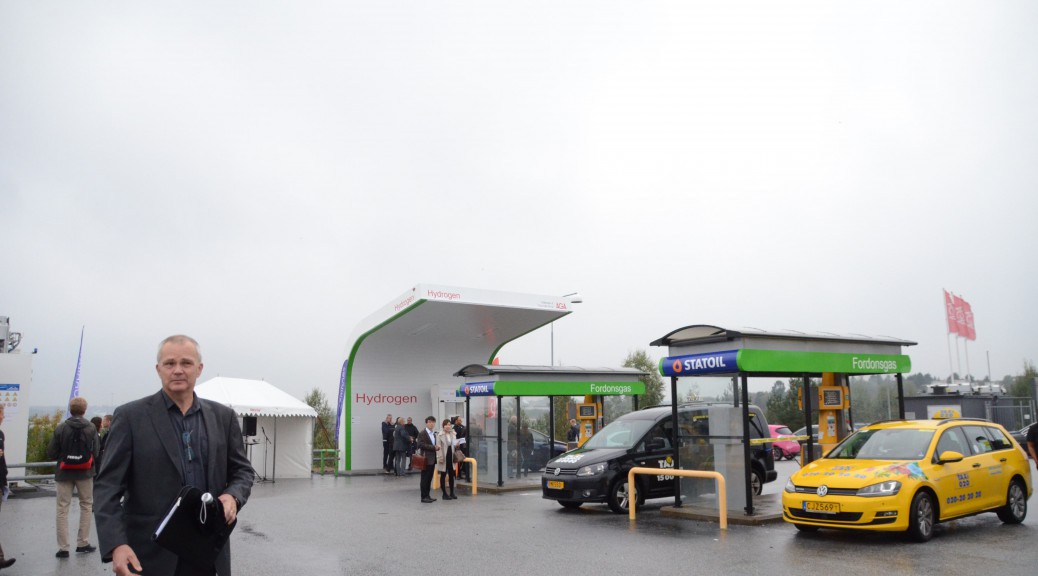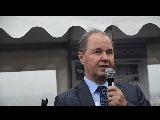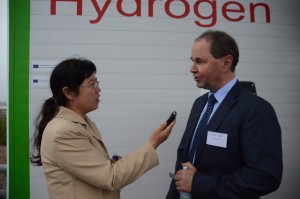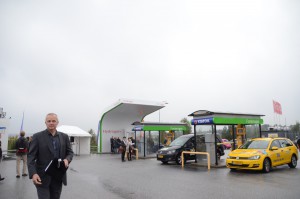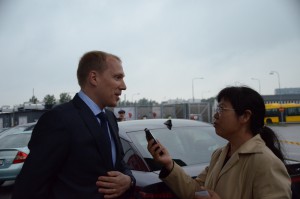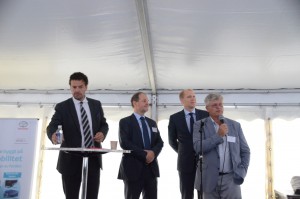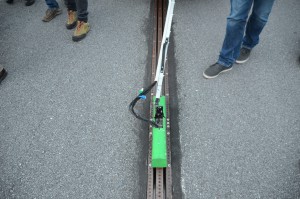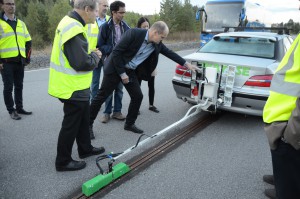Monthly Archives: September 2015
China’s fiscal revenue growth plummets, spending leaps
|
China denies recalling 1 trillion yuan of unspent fiscal budget
|
Yantai city planning for 2011-2020 approved by State Council
BEIJING, Sept. 16 (Greenpost) — The State Council, China’s cabinet, has approved the urban planning for 2011-2020 of Yantai city, Shandong province, east China.
Under the planning, by 2020, the downtown area of Yantai will have a maximum population of 2.3 million and urban construction land area should be restricted within 255 square kilometers.
The planning also requires improvement of roads, waterways, railways and airports. Enditem
Source Xinhua
Iceland to recommend parliament to prove support for refugees
By Xuefei Chen Axelsson
Stockholm, Sept.20 (Greenpost)– Icelandic government of has decided to recommend to Parliament that 2 billion ISK (14 million EUR) will be provided for support to refugees and asylum seekers in the course of next 15 months in order to respond to the alarming refugee crisis due to the conflict in Syria.
According to a press release from Reykjavik reaching here, the fund will be used to support office of the United Nations High Commissioner for Refugees, UNHCR, UNICEF, UN Central Emergency Relief Fund and the World Food Program. If Iceland receives refugees, it will receive it through the UN organisations.
To strengthen measures that can radically change and expedite the processing of asylum applications and respond to the huge increase in their numbers, thereby reducing uncertainty and inconvenience.
The newly appointed Ministerial Committee on refugees and immigrants will provide detailed suggestions for the allotment of funds, and these shall be ready prior to Parliament’s second reading on the financial budget for 2016.
葛剑雄教授在斯京做丝绸之路与“一带一路”报告
北欧绿色邮报网报道(记者陈雪霏)——复旦大学中国历史地理研究所葛剑雄教授19日上午在斯德哥尔摩瑞青中文学校做了主题为中国历史上的丝绸之路与“一带一路”,“中国文化与世界”的精彩报告。
葛剑雄教授在斯京做一带一路报告。 陈雪霏拍摄。
葛教授说,古代丝绸之路和一带一路有很大区别。古代丝绸之路是中亚乃至欧洲国家到中国来,中国被迫应对而时断时续地形成了丝绸之路。
就像习近平主席指出的中国没有对外侵略的基因,确实在中国历史上从来没有侵略外国的行为,因为中国的古代帝王认为普天之下,莫非王土。其他国家都是蛮夷,不需要走出去。
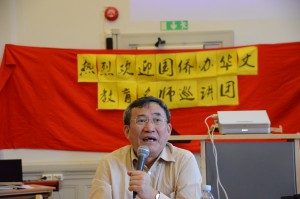 但是,现在的一带一路是在中国经济增长出现瓶颈,产能过剩,经济面临转型升级的背景下,中国主动要走通一带一路。这需要中亚地区的稳定和安全。这是一个很好的发展机遇同时也面临着巨大的挑战。葛教授谈古论今,谈笑风生,惟妙惟肖地把中国历史和周边历史向大家娓娓道来。
但是,现在的一带一路是在中国经济增长出现瓶颈,产能过剩,经济面临转型升级的背景下,中国主动要走通一带一路。这需要中亚地区的稳定和安全。这是一个很好的发展机遇同时也面临着巨大的挑战。葛教授谈古论今,谈笑风生,惟妙惟肖地把中国历史和周边历史向大家娓娓道来。
本次讲座是国侨办华文教育名师巡讲团斯德哥尔摩巡讲的一部分。本次培训由中国国务院侨办华文教育中心主办,瑞典华人总会承办。
 正如瑞青中文学校校长王梅双在开头介绍的,其主要目的是为进一步提高瑞典华文教师的中华语言文化素养和教学水平,推动华文教育朝标准化,正规化,专业化方向发展。
正如瑞青中文学校校长王梅双在开头介绍的,其主要目的是为进一步提高瑞典华文教师的中华语言文化素养和教学水平,推动华文教育朝标准化,正规化,专业化方向发展。
下午,延边大学人文学院中文专业孙惠欣教授和北京师范大学试验小学教学主任贾红斌分别就教师规范用语,演讲与口才,发音和语法等进行了讲座和研讨。
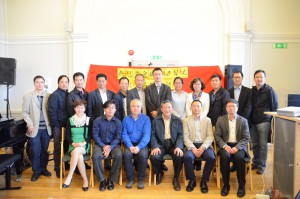 本次活动得到了有关各方的积极响应。出席上午的报告会的有中国驻瑞典大使馆领事部主任郭延航,瑞典华人总会执行主席叶沛群,副主席伍王令,青田同乡会会长叶克雄和北欧时报董事长郑王平等斯京的各路侨领和中文老师。出席下午培训的大部分是中文教师。一共有近百人参加了报告会和培训会。
本次活动得到了有关各方的积极响应。出席上午的报告会的有中国驻瑞典大使馆领事部主任郭延航,瑞典华人总会执行主席叶沛群,副主席伍王令,青田同乡会会长叶克雄和北欧时报董事长郑王平等斯京的各路侨领和中文老师。出席下午培训的大部分是中文教师。一共有近百人参加了报告会和培训会。
本次培训持续两天,20日还将在ABF举行一天。
北欧绿色邮报将对葛教授的讲座进行进一步的详细后续报道。
敬请关注。
著名汉学家林西莉新书《另一个世界》出版发行
北欧绿色邮报报道(记者陈雪霏)--瑞典著名汉学家林西莉的第三本关于中国的书《另一个世界》日前在斯德哥尔摩出版发行。
林西莉17日在市中心的Hendgren书店进行演讲并签名售书之后接受了北欧绿色邮报网记者的采访。
林西莉接受北欧绿色邮报记者采访。 丹妮拍摄。
“这部书主要收集了我在1961-1962年在中国留学时的生活和老北京在那两年的生活。一开始我在北大留学,感觉非常糟糕,一切都是政治挂帅。后来,我开始学习古琴,结果我发现了非常好的老师,非常优美的音乐和非常悠久的文化。我开始真正了解中国文化。”
林西莉此前已经写过《汉字王国》瑞典语写的,已经翻译成中文。第二本《古琴》也是瑞典语翻译成中文。都获得瑞典著名的文学最高奖奥古斯特奖。而且《古琴》很畅销,在排行榜上仅次于《习近平》。
她说,那个时候因为没有多少人有照相机,即使有,照普通群众日常生活的照片也是非常宝贵的,都是独家的。本书中收集了1961-1962两年的190张照片反映当时老北京的生活。
 她在演讲中说,当时非常困难,由于缺乏蛋白质,她总是掉头发。但是,在学习古琴时,她却是当时唯一的学生,这给了她得天独厚的机会,让她能够沐浴在古琴学习中随时可以问好几个老师。
她在演讲中说,当时非常困难,由于缺乏蛋白质,她总是掉头发。但是,在学习古琴时,她却是当时唯一的学生,这给了她得天独厚的机会,让她能够沐浴在古琴学习中随时可以问好几个老师。
 1978年改革开放后,她带领学生到中国去。她写《古琴》书希望能把这方面的知识流传下去。她写《汉字王国》,希望通过象形文字的形状了解它们的意思,非常有效。后来,她发现,她的书成了中外的教材,中国的古琴业也出现了繁荣发展,看到大批中国青年学习古琴,很多厂家生产古琴,带动一个产业,很多地方有古琴表演,这让她感到有很大安慰。她非常高兴看到古琴的流行。
1978年改革开放后,她带领学生到中国去。她写《古琴》书希望能把这方面的知识流传下去。她写《汉字王国》,希望通过象形文字的形状了解它们的意思,非常有效。后来,她发现,她的书成了中外的教材,中国的古琴业也出现了繁荣发展,看到大批中国青年学习古琴,很多厂家生产古琴,带动一个产业,很多地方有古琴表演,这让她感到有很大安慰。她非常高兴看到古琴的流行。
林西莉几乎年年都到中国去访问,参加各种会议,及时了解中国的发展变化。她曾经学习艺术史,考古史,当过中文老师,当过记者。晚年能够专心致志地著书,写出的都是精品。
AGA第一座液氢加气站在斯德哥尔摩阿兰达机场揭幕
北欧绿色邮报网报道(记者陈雪霏)--全球液氢领先的林德集团成员AGA有限公司北欧地区总经理布.杜尔沃尔德17日在斯德哥尔摩阿兰达机场为其在瑞典设立的第一家液氢加气站揭幕剪彩。
“该加气站的液氢是在三德韦克用风电生产的。通过风电把水分子分解成氢气和氧气,这是很好的绿色循环。” 杜尔沃尔德说。
他说,他们打算在今后四五年间全球氢气加气站将达到1000多家。
林德集团是德国的一家全球领先的气体和工程相结合的集团公司。在中国宁波有分公司。但其业务主要是利用液氮进行水产保鲜。
同时参加揭幕仪式的有韩国的现代汽车和日本的丰田汽车。二者都在瑞典和北欧有销售业务。现代汽车在瑞典汽车市场占比为4%。
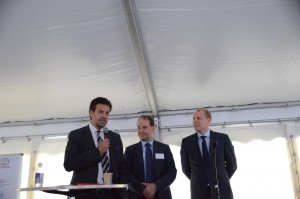 现代汽车副总裁克里斯蒂安.努尔贝在接受记者采访时说,这个液氢加气站真是太好了,只通过一点水就可以产生氢气,这样可以实现汽车零排放。现代汽车已经完全可以使用这样的燃料,马上下订单,三个月就可以交货。
现代汽车副总裁克里斯蒂安.努尔贝在接受记者采访时说,这个液氢加气站真是太好了,只通过一点水就可以产生氢气,这样可以实现汽车零排放。现代汽车已经完全可以使用这样的燃料,马上下订单,三个月就可以交货。
丰田汽车北欧总裁萨维尔.黑篮在接受记者采访时表示心情非常激动因为他已经在丰田工作19年了,从一开始非常简单的小车型,发展到今天的米莱品牌,他真是感觉非常激动。尤其是现在能够使用氢气来当燃料,可以百分之百地实现清洁,实现零排放。这真是大好事一桩。他很高兴与AGA合作。
尽管这是德韩日三国公司的合作,但是业务是在瑞典的地盘上展开的。他们都对汽车的节能减排感兴趣,因此,很自然地走到了一起。而瑞典也是一个在节能减排绿色技术方面走在世界前列的国家。AGA的Hydragen加气站就设立在阿兰达机场的生物燃气加气站里。因此,是多边合作共赢的结果。
(采访照片由丹妮拍摄)
瑞典呼吁欧盟同意各国通过税收鼓励使用生物能源
北欧绿色邮报报道(记者陈雪霏)--瑞典国际生物能协会Svebio会长,CEO古斯塔夫梅林16日呼吁欧盟统一支持各国通过税收鼓励使用生物能源。
他说,瑞典前几天实行了通过税收调节鼓励使用生物能的政策效果很好。他是在接受北欧绿色邮报记者采访时说这番话的。
他说,为期两天的高级生物燃料大会在飞机场召开本身就是想向大家展示,生物能的质量很好,飞机上都可以使用混合能源了。本次大会主要讨论上到飞机,下到陆地和海上轮船等交通工具如何实现2030年实现交通0排放,或者说不使用任何化石燃料的远景目标做贡献。
梅林说,瑞典目前在交通方面已经实现了12%的生物能,这是过去五年来取得的成绩。
会上,英国,美国,芬兰和瑞典,以及欧盟的代表都介绍了各自的经验和研究成果。
瑞典正在试验电气化公路
北欧绿色邮报网报道(记者陈雪霏)--瑞典NCC道路建设公司旗下的电气化公路公司(Elways)目前正在进行电气化公路充电试验。

 Elways负责人介绍说,此前人们有很多设想,最有名的就是在空中建立轨道让后让轿车在6米高的轨道上行走。计算下来,成本太高。而他所发明的公路上的微型双轨主要是用来充电的。
Elways负责人介绍说,此前人们有很多设想,最有名的就是在空中建立轨道让后让轿车在6米高的轨道上行走。计算下来,成本太高。而他所发明的公路上的微型双轨主要是用来充电的。
 这位负责人说,对于电动车来说最大的问题是电池的电力不足。充一次电只能跑最多不到100 公里。如果是大卡车,需要的电池更多,更重。很不方便。那么他发明的电动轨道是两个一厘米宽的两个槽,电动车可以通过走这个轨道的过程来充电。这样,跑上一段时间,就可以把电充满了。
这位负责人说,对于电动车来说最大的问题是电池的电力不足。充一次电只能跑最多不到100 公里。如果是大卡车,需要的电池更多,更重。很不方便。那么他发明的电动轨道是两个一厘米宽的两个槽,电动车可以通过走这个轨道的过程来充电。这样,跑上一段时间,就可以把电充满了。
这位负责人说,他们设想电动轨道要建在高速公路上,这样会更安全。针对冬季的下雪,夏天的下雨问题,他们一年四季已经试验3年了,在任何天气情况下都试验过了,没有问题。目前他们只建了150米长的充电轨道。
这样的建筑成本不及空中轨道的五分之一或六分之一。因此,容易让人接受。根据目前的进口能源花费,两年就能收回成本。同时,他们在和瑞典的邮政部门合作,希望将来邮政用车都用这种充电轨道。
与其说是电气化公路,其实也可以说是一个可以在上面运行的充电桩。发明人说,有了这样的轨道,其实汽车改造是很简单的事情。
 预计,再有两三年,这个试验就会有结果是否上马。目前,这是瑞典有关方面认为实现可持续交通的一个可行性项目,因此,一直在给予资助进行试验。参与的有11家公司,企业,皇家科技学院,瑞典道路交通管理局,阿兰达机场和斯德哥尔摩市。
预计,再有两三年,这个试验就会有结果是否上马。目前,这是瑞典有关方面认为实现可持续交通的一个可行性项目,因此,一直在给予资助进行试验。参与的有11家公司,企业,皇家科技学院,瑞典道路交通管理局,阿兰达机场和斯德哥尔摩市。
记者是在参加瑞典生物能源协会组织的高级生物能源大会期间进行上述采访的。
另外,此前,记者还走访了一个生产铺路用的沥青混凝土材料。他们说,他们的生产过程非常节能,因为他们利用回收的原料来生产,也生产低温沥青,只有18度。
Stockholm Lifetime Achievement Award 2015 goes to director Stephen Frears

Stockholm, Sept. 16(Greenpost)– 2015 Stockholm Lifetime Achievement Award will go to director Stephen Frears.
During the premiere of his latest film The Program, Frears will visits Stockholm International Film Festival to receive the Bronze Horse.
Justification: British director Stephen Frears never shies away from taking on people’s dark and tragic sides, doing so with warmth, passion and a sense of humor.
This year’s receiver of the Lifetime Achievement Award is a filmmaker who is not afraid to take a stand for those who exist at the margins of society. His filmmaking ranges from political films with social pathos to grand epics with the biggest stars. Regardless of what form the story takes, Stephen Frears shows us that he is a director with a genuine curiosity for people’s life stories.
Stephen Frears has since his breakthrough with My Beautiful Laundrette (1984) mesmerized the audience with a series of acclaimed films. The director has been nominated for two Oscars with The Grifters (1990) and The Queen (2006), and awarded with the Silver Berlin Bear for The Hi-Lo Country (1998) at the Berlin International Film Festival. His latest film Philomena (2013) was shown during the Stockholm International Film Festival two years ago and was praised by both audiences and critics.
In the exhilarating thriller The Program (2015), Frears narrates the dramatic story of Lace Armstrong. The undefeated Tour de France champion was discovered to be involved in the most sophisticated doping program in the history of cycling. Starring Ben Foster as Armstrong and Chris O’Dowd as David Walsh, the journalist who devoted years to reveal the scandalous fraud, The Program is a gripping story with a deeply psychological portrait of its main characters.
Cast: Ben Foster, Lee Pace, Dustin Hoffman, Chris O ‘Dowd, Elaine Cassidy, Jesse Plemons, Laura Donnelly.
The Program has premiere in Swedish cinema December 4. Distributor: AB Svensk Filmindustri.
The Stockholm Lifetime Achievement Award is presented annually to honor and acknowledge a longstanding career and an outstanding achievement in cinema. The prestigious award, in the shape of a 7,3kg (16 lb) Bronze Horse is the heaviest film award in the world. It is also a paraphrase on a national design icon, the Swedish Dala horse, and was created by artist Fredrik Swärd. The prize has previously been awarded to directors such as Jean-Luc Godard, Quentin Tarantino, David Cronenberg, David Lynch, Oliver Stone and Mike Leigh.
Spotlight: China economy enters “new normal” eyeing 7 pct growth rate: G20
ANKARA, Sept. 5 (Xinhua ) — The Chinese economy has entered a “new normal” status and the growth rate of economy is predicted to be around 7 percent in the coming 4 to 5 years, said Chinese Finance Minister Lou Jiwei here on Saturday.
Lou said it in a written statement after the 2-day G20 Finance Ministers and Central Bank Governors Meeting in Ankara Turkey.
Zhou Xiaochuan, People’s Bank of China governor pointed out in the joint statement that there is no foundation that RMB will keep devaluing for a long term.
Zhou Xiaochuan stated that the bubble in Chinese stock market keep increasing before June 2015. The Shanghai Composite Index has mounted up 70 percent from March to June.
Risks as Investors leverage rapid rise occur during this period of time. China has implemented the correction phase of stock market for three times among which the third time in August has some global impacts.
China has been taking measures to prevent its economy from systematic risk including the PBOC providing liquidity to the market through multiple channels.
The measures taken by Chinese government has prevented the stock market from decline in precipice way and the occurrence of systematic risk.
According to the statement, since the August correction in stock market, the Investors leverage in Stock market has been going down significantly and the real economy has not been impacted.
The reform of the middle price quotation of RMB exchange rate mechanism on August 11 is an important step to the marketing reform of RMB rate.
RMB was devalued for a certain degree after the reform, but the RMB was over valued for reasons like the value-up of U.S. dollar ,the generally value depreciate of Currency in emerging market economies.
“But there is no substantial transformation in the real economy of China and large surplus still remains in the foreign trade of China, so there is no foundation that RMB will keep devaluing for a long term,” Governor Zhou strengthened in the Statement.
“The status of Chinese economy is till in predication. The Chinese Economy has entered a “new normal” status and the growth rate of economy is predicted to be around 7 percent in the coming 4 to 5 years” Chinese Finance Minister of Lou Jiewei said in the joint statement.
It is stated that there are mainly two reasons that the growth rate of China will enter the 7 percent period.
Firstly, the rapid growth rate which keeps 9-10 percent in the past and highly depends on the stimulation of policy is not sustainable, and is over the potential growth rate of China which lead to over capacity and mass increase of inventory. It will take years to consume these over capacity and inventory.
The next 5 years will be a painful period for the reform of Chinese economy, and the main goals need to be achieved by 2020. China’s economy will be mainly driven by consumption rather than investment and foreign trade during the reforming period, and this will not be an easy job to accomplish.
Secondly, China’s economic cycle is different with the developed countries. Developed countries generally initiated the process of deleveraging after the global crisis, however, China initiated its leveraging process between 2009 and 2010 and achieved the 10 percent in growth rate.
The contribution rate to growth of global economy was as high as 50 percent above during that time. China now is initiating its process of deleveraging and the growth rate will down to 7 percent but still making 30 percent contribution rate to growth of global economy.
Lou stressed in the statement that there are some positive changes in Chinese economy despite the lower of growth rate, including the contribution rate to growth of consumption comes higher than that of investment, the proportion of service in GDP over passed industry, the proportion of trade surplus in GDP has been decreasing, 7 million new jobs was created in the first half year, the quality of economic growth keeps rising etc.
China will continue to implement a proactive fiscal policy and the increasing rate of central government spending is predicted to be 10 percent, which is higher than the 7 percent budget.
China is taking measures to plug fiscal gap to maintain moderate economic growth and support the structural reform, the statement added.
“The Chinese government will not pay particular attention to a seasonal short term economic fluctuation, and will keep the stability of macroeconomic policies,” Lou pointed out in the statement.
China has achieved a 7 percent growth despite the decreasing of demographic dividend and falling on rate of capital return.
The huge potential of Chinese economy lies in reform and China is unswervingly promote reform and opening up in accordance with the established plan.
“G20 financial ministers and central bank governors have talked about the economy problems in China and we are not pessimistic about China keeping the 7 percent growth rate in the future,’ Deputy Prime Minister of Turkey Cevdet Yilmaz said in the press conference Saturday in Ankara. Enditem
China Exclusive: China in transition to gain more clout in global governance, tech-led
DALIAN, Sept. 8 (Xinhua) — Global institutions should better represent the world’s emerging economies, chief among them China, to reflect shifting geo-political realities, said Klaus Schwab, founder and executive chairman of the World Economic Forum, on Tuesday ahead of its annual summer meeting in China.
Robust economic growth from countries like China and India are signs that Asia is once again the economic center of the world, a fact that Schwab said is not being adequately reflected in international governance.
China has long sought greater clout in global institutions commensurate with its growing economic might. The country has led the creation of the Asian Infrastructure Investment Bank, an alternative to the International Monetary Fund and the World Bank, with both developing and developed countries as its perspective founding members.
“I’m very happy that China is taking leadership in developing infrastructure not only in China, but having regional cooperation,” Schwab said.
He said that rather than competing with the IMF and the World Bank, the AIIB will complement existing institutions to fund a trillion dollar infrastructure investment gap, much of it in Asia.
China’s outreach also comes at a time when growth in the world’s second largest economy is moderating on soft investment and trade. Economic growth slowed to 7 percent during the first half this year as traditional drivers such as real estate, heavy industries and exports run out of steam.
But Schwab said the slowdown is “a necessity to transform the economy from production and export-oriented to a more consumer-led and innovation-based model.”
“The future growth will come not so much from traditional sources like manufacturing….China has to orientate its economy towards innovation and creativity,” Schwab said.
China’s vast manufacturing sector has been saddled with overcapacity as domestic and global demand for its industrial goods have weakened amid economic slowdown.
Authorities have since this year announced plans to nurture tech-intensive industries to help China regain its competitive edge in manufacturing. Meanwhile, China’ s budding internet sector has churned out a legion of innovative firms from Alibaba and Tencent to taxi-hailing startup Didi Kuaidi that helps the economy adapt to its new consumers.
These companies, and western equivalents such as Uber and Airbnb, have come up with what Schwab called “a new approach to old business models,” and brought innovation “not just to one product, but the whole system.”
Competitiveness of the Chinese economy in this new era of disruptive technologies, he said, will come from the agility and speed at which businesses adopt new technologies.
“I’ve seen China confronted many times with what seem insurmountable problems,” Schwab said, “What I’m always impressed with is the vision behind China’s economic policies, which allows the country to meet those challenges.” Enditem
Spotlight: China economy enters “new normal” eyeing 7 pct growth rate: G20
ANKARA, Sept. 5 (Xinhua ) — The Chinese economy has entered a “new normal” status and the growth rate of economy is predicted to be around 7 percent in the coming 4 to 5 years, said Chinese Finance Minister Lou Jiwei here on Saturday.
Lou said it in a written statement after the 2-day G20 Finance Ministers and Central Bank Governors Meeting in Ankara Turkey.
Zhou Xiaochuan, People’s Bank of China governor pointed out in the joint statement that there is no foundation that RMB will keep devaluing for a long term.
Zhou Xiaochuan stated that the bubble in Chinese stock market keep increasing before June 2015. The Shanghai Composite Index has mounted up 70 percent from March to June.
Risks as Investors leverage rapid rise occur during this period of time. China has implemented the correction phase of stock market for three times among which the third time in August has some global impacts.
China has been taking measures to prevent its economy from systematic risk including the PBOC providing liquidity to the market through multiple channels.
The measures taken by Chinese government has prevented the stock market from decline in precipice way and the occurrence of systematic risk.
According to the statement, since the August correction in stock market, the Investors leverage in Stock market has been going down significantly and the real economy has not been impacted.
The reform of the middle price quotation of RMB exchange rate mechanism on August 11 is an important step to the marketing reform of RMB rate.
RMB was devalued for a certain degree after the reform, but the RMB was over valued for reasons like the value-up of U.S. dollar ,the generally value depreciate of Currency in emerging market economies.
“But there is no substantial transformation in the real economy of China and large surplus still remains in the foreign trade of China, so there is no foundation that RMB will keep devaluing for a long term,” Governor Zhou strengthened in the Statement.
“The status of Chinese economy is till in predication. The Chinese Economy has entered a “new normal” status and the growth rate of economy is predicted to be around 7 percent in the coming 4 to 5 years” Chinese Finance Minister of Lou Jiewei said in the joint statement.
It is stated that there are mainly two reasons that the growth rate of China will enter the 7 percent period.
Firstly, the rapid growth rate which keeps 9-10 percent in the past and highly depends on the stimulation of policy is not sustainable, and is over the potential growth rate of China which lead to over capacity and mass increase of inventory. It will take years to consume these over capacity and inventory.
The next 5 years will be a painful period for the reform of Chinese economy, and the main goals need to be achieved by 2020. China’s economy will be mainly driven by consumption rather than investment and foreign trade during the reforming period, and this will not be an easy job to accomplish.
Secondly, China’s economic cycle is different with the developed countries. Developed countries generally initiated the process of deleveraging after the global crisis, however, China initiated its leveraging process between 2009 and 2010 and achieved the 10 percent in growth rate.
The contribution rate to growth of global economy was as high as 50 percent above during that time. China now is initiating its process of deleveraging and the growth rate will down to 7 percent but still making 30 percent contribution rate to growth of global economy.
Lou stressed in the statement that there are some positive changes in Chinese economy despite the lower of growth rate, including the contribution rate to growth of consumption comes higher than that of investment, the proportion of service in GDP over passed industry, the proportion of trade surplus in GDP has been decreasing, 7 million new jobs was created in the first half year, the quality of economic growth keeps rising etc.
China will continue to implement a proactive fiscal policy and the increasing rate of central government spending is predicted to be 10 percent, which is higher than the 7 percent budget.
China is taking measures to plug fiscal gap to maintain moderate economic growth and support the structural reform, the statement added.
“The Chinese government will not pay particular attention to a seasonal short term economic fluctuation, and will keep the stability of macroeconomic policies,” Lou pointed out in the statement.
China has achieved a 7 percent growth despite the decreasing of demographic dividend and falling on rate of capital return.
The huge potential of Chinese economy lies in reform and China is unswervingly promote reform and opening up in accordance with the established plan.
“G20 financial ministers and central bank governors have talked about the economy problems in China and we are not pessimistic about China keeping the 7 percent growth rate in the future,’ Deputy Prime Minister of Turkey Cevdet Yilmaz said in the press conference Saturday in Ankara. Enditem
Analysis: Why didn’t western leaders attend the Beijing 9.3 Parade?
By Xuefei Chen Axelsson
This morning I called my mother who is in Beijing. She told me that during the 9.3 military parade in Beijing, the weather was extremely good and the blue sky really appeared which made her very happy.
Then she asked me a question with some disappointment.
“Why didn’t your country leader come to Beijing to attend the 9.3 Parade?” she asked.
I didn’t know how to answer this question. I said because we had a big time difference of 6 hours. So when Beijing began the parade, we were sleeping. But I know the Beijing people who happened to be in Stockholm didn’t sleep and watched the parade with smartphones and followed the rythem of the motherland.
Then I said maybe because Russian Prime Minister Vladimir Putin was there so the west didn’t like him and they didn’t attend. Or maybe because they were not happy to see China was very strong.
I learnt that Sweden commented about the bombing of Hiroshima and Nagasaki which helped ended the Second World War and the Japanese invasion of China. Now they said there should be no atomic bombs and under no circumstance can man use it.
That was in the belief that we don’t want any war, we only want peace.
I said but there are large scale reports about the parade in Swedish media.
But why didn’t western leaders attend the parade? To be honest, I didn’t know. I thought they might feel not very happy.
What do you think? leave your comments.
News Analysis: Fiscal stimulus to assume bigger growth-supportive role
BEIJING, Sept. 9 (Xinhua) — Although growth uncertainties abound home and abroad, China has plenty of policy options — especially on the fiscal front — to put the economy on track to deliver the around 7 percent annual target.
In its latest effort, the Ministry of Finance on Tuesday put forward multiple fiscal policies aimed at stabilizing growth, such as coordinating funds to accelerate project construction, activating idle money and widening tax breaks.
Other measures include guidance funds for small and emerging businesses, and promoting public-private-partnerships (PPP).
China is battling a property downturn, industrial overcapacity, sluggish demand and struggling exports, which dragged growth down to 7 percent for the first half (H1) of the year.
On top of that, fresh pressures from capital market volatility, currency devaluation in emerging markets, and slumping global commodity prices are further muddying growth prospects.
To achieve the full year growth target, the ministry said it will closely monitor the changing dynamics in the economy and respond with more effective and targeted fiscal policies to support growth, an area where analysts say hold vast potential to shore up growth.
Fiscal surplus for the January-July period was 383 billion (60.22 billion U.S. dollars), leaving plenty room for expansionary policies to increase the budget deficit to 2.3 percent of GDP for 2015, up from last year’s target of 2.1 percent.
Within annual budget, China could record a fiscal deficit of 2.1 trillion yuan for the August-December period, 200 billion yuan more than the same period last year, according to a recent report by China International Capital Corp. (CICC).
In addition, the government’s ongoing drive to activate unspent fiscal funds will make the expansionary fiscal policy more sustainable.
According to the finance ministry, some 13.1 billion yuan of idle fiscal funds have been retrieved and will be redistributed to growth-stabilizing sectors, and 243.8 billion yuan recovered to local budgets.
The more efficient use of idle fiscal funds is equivalent to increasing the government’s disposable funds beyond the budget without raising the government sector’s debt ratio, noted a CICC report.
Meanwhile, to dissolve debt risks of local governments, China has allowed them to replace existing debts with new bonds. The top legislature has approved the expansion of a debt swap program for local governments worth 3.2 trillion yuan in 2015.
On the back of such fiscal support, China has stepped up spending on key infrastructure such as railways in the western regions, renovation of substandard housing and underground utilities, which have all helped boost economic activity already.
“We think infrastructure-investment growth will likely be revived from July’s 16 percent year on year to 20 percent in the coming months, which in turn will provide, at the very least, a counterbalance against China’s ongoing property and heavy industry downturn,” noted a UBS report.
In an assuring message to the market, China’s top economic planner on Monday said the world’s second largest economy is stabilizing and turning for the better, citing stabilizing power use, rail freight and a warming property market as proof for the improvement.
“The economic operation is expected to maintain steady expansion to realize the full-year growth target,” the National Development and Reform Commission said. Enditem

